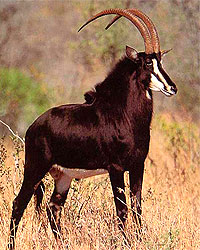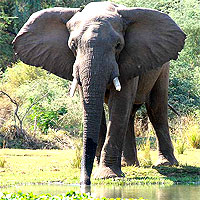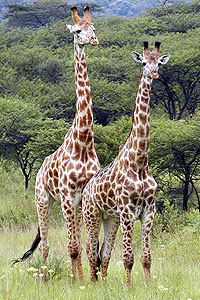Shimba
Hills National Park
The
National Reserve lies Approximately 33 Kilometers
South of Mombasa Town, in Kwale District of Coast
| Kenya
(Shimba
Hills National Park is close to Mombasa. Shimba Hills
National Park is a small hilly plateau situated at
33 kilometers (20 miles) South West from Mombasa (near
Kwale Town).
Shimba
Hills National Park —
Kenya
Shimba Hills National Park is close
to Mombasa. Shimba Hills National Park is a small
hilly plateau situated at 33 km South West from Mombasa
(near Kwale Town). This pristine wonderland of rolling
Meadows and forests of giant primeval trees harbors
a wide variety of wildlife, including some 500 elephant
that favor the refreshing fruit of the borassus palm.
There
are leopards often heard but not frequently seen.
But the most distinctive of the Shimba Hills National
Reserve's many species is perhaps the rare and impressive
Sable antelope, found in the same habitats as several
large herds of buffalo.
While
never numerous in Kenya it is unlikely that viable
populations exist other than in the Shimba Hills.
Closely related to the Roan antelope, which it resembles,
it is in fact, slightly smaller. Both sexes carry
the 100-160 centimeter horns, which rise vertically
before curving backward in a pronounced arc.
Visiting
the park is a great opportunity to discover the dry
red-soil of inland Kenya by doing a real safari and
observing African elephants while being near the coast
and still enjoying the freshness of the coastal breeze.
The
park is well managed, the road is good all year round
and there are plenty of signposts, to direct you.
These is also a few choice of accommodation for those
willing to pass the night in an equatorial forest
populated by elephants or for sundowners lovers.
Shimba
Hills is the name of the hills rising above the palm-fringed
reaches of Kenya's coastline. Surrounded by a forested
area of approximately 24'000 hectares, the park has
a unique wooded ecosystem rich in flora but also in
fauna - with all the same elephants, giraffes and
the rare sable antelopes.
Shimba
Hills National Reserve vegetation is very dense therefore
the few pastures and grasslands available are the
best places to view animals who usually move towards
rivers to drink and plains to graze.
They
are on eastern side of the park near the Giriama point,
the Longo forest or the Buffalo ridge. Because it
is very hot, animals stay in the forest during the
day and no animals are seen.
The
best time is late in the afternoon. The main attraction
of the park are the Sheldrick falls, an impressive
25 meters high waterfall of fresh spring water, and
its marked footpath in gallery forest to see the falls.

|
Sable
Antelopes at Shimba
Hills National Park
Shimba
Hills National Park is
fairly small park and is also the sanctuary
of the last breeding herd of indigenous
Sable Antelope in Kenya. This typical
sabre-horned antelope is often considered as
the most beautiful of the large antelopes.
They are more
easily seen on the central grasslands (Buffalo
ridge) and around the old airstrip (near Longo
forest). Best time is early morning or late
afternoon.
Large and gregarious
animals with long scimitar-shaped horns, they
have a black color coat marked with white stripes
on their face and under-parts. In the past,
this African savanna antelopes were preys of
many hunters and the species was almost extinct
in Kenya.
Even Ernest
Hemingway was used to hunt Sable Antelopes despite
the fact he was astonished by the beauty and
the habits of the antelopes, both developed
in his book, The Green Hills of Africa.
|
Shimba
Hills National Park
is a unique habitat for Elephants
For
those who have been in safari and have seen
savannah elephants under acacia cover and savannah
in backdrop, Shimba Hills National Park is a
good alternative to view Elephants in a forested
area.
The
tropical forests of Shimba Hills National Park
are a unique habitat for Elephants of the Kenyan
coast.
The best place to spot them is in the Elephant
Hill or along the forested area such as Longo
forest, but herds can be seen all over the Park
as there is more than 600 Elephants in the area.
Note
also that a fenced Elephant corridor connects
the Shimba Hills National Park to the Mwaluganje
Forest and its Elephant Sanctuary. |

|

|
Wildlife
in Shimba
Hills National Park
Shimba
Hills National Park vegetation cover is dense
and the weather is very hot during the daytime
hours, animals are shy, stay most of the day
in the forest and are very hard to see.
A
late afternoon visit is recommended. Besides
the Elephants and the Sable Antelopes, other
animals in the Park include Buffalo, Waterbuck,
Bushbuck, Hyena, Warthog, Leopard, Baboon, Sykes',
Vervet and Colobus monkeys, Serval, Duiker,
Suni and Bush pig.
The
Masai Giraffe and Ostrich have been reintroduced
in the Park and Impalas and Zebras have been
unsuccessfully reintroduced. The rare Roan Antelope
is a relative to the Sable Antelope also found
in Shimba Hills.
This antelope can also be seen in Masai Mara
National Reserve. Birdlife is also abundant,
especially during spring migration as 111 bird
species have been recorded, of which 22 are
coastal endemic. |
Ocean
View Point & Giriama Points
Shimba
Hills National Park has many viewpoints all
with views over the forested hills and the grass
plains. These viewpoints are used to observe
Elephants so binoculars is a must. The eastern
side of the Park has more viewpoints than the
western side and the scenery is more contrasted
with forests and plains.
At
the western side of Shimba Hills National Park,
the Pengo hill (450 m) is the highest point
of Shimba hills and on a very clear day, the
Tsavo plains and the Taita Hills can be seen
(and sometimes Mount Kilimanjaro).
Ocean
view point offers a panoramic views over the
hilly countryside and as far as the Kenyan coast
and the Chale Island and there is a picnic site.
The Giriama point is on the way towards Sheldrick
Fall |
Shimba
Hills National Park Sheldrick
Falls
Note:
Shimba
Hills National Park Sheldrick
Falls visit has to be
accompanied
by a Kenya Wildlife Service Ranger Guide
(for safety reasons) as there are sometimes
Elephants or few Cape Buffalos along the
2 km long way-marked footpath going to
the falls.
It's
also advisable to take a Safari Hat and
bottle water before setting out going
to the forest walk as the path crosses
steep uncovered grass plains and it can
get very hot at times. The falls were
discovered by David Sheldrick.
The
pleasant walk takes two hours from the
car park area to the falls which supply
Tiwi and Diani beaches of Mombasa with
water.
The
track leading down to the cascade offers
a scenic walk, count 45 minutes to descend
and 1 hour to return.
At
the fall, don't try to climb on the cliff
as it is slippery but take a cold shower
of 25 meters high, swim safely in the
cool water pool or even have a picnic
by the cascades on the sand.
The
level of the pool depends on the season
you are visiting. During rainy season,
you can easily swim in the pool and there
is one fall while during dry season, the
pool is tiny and there are two spring
water falls.
|
Shimba
Hills National Park Facts
Altitude
:
120 - 450 meters
Area :
321 Square Kilometers
Location : 33
Kilometers south of Mombasa - District of Kwale (Coast
Province)
Entrances :
one main entrance and three secondary gates (Kivumoni
Gate, Kidongo Gate, Shimba Gate). Shimba
Hills National Park
has a small Airstrip
Shimba
Hills National Park Highlights
* Sheldrick Waterfalls (25 meters high)
*
Unique presence of the sable antelope
*
Splendid views towards the Indian Ocean and Mt Kilimanjaro
* Possibility to go for walk at the falls and to plunge
in the pool.
* Picnic sites, camping sites and self-catering accommodation
available
*
Large rainforest surrounding the park (Mkongani and
Mwaluganje forests)
* Possibility to do safari easily accessible from Mombasa
: elephant, giraffe, buffalo, roan antelope and leopard
Shimba
Hills National Park
List of Animals
Antelopes
& Gazelles |
Ungulates
& Mammals |
Carnivores
|
Primates
|
Suni
Steinbok
Bushbuck
Blue
Duiker
Coastal
Topi
Roan Antelope
Sable
Antelope
Common
Duiker
Harvey’s
Duiker
Common
Waterbuck
|
Masai
Giraffe
Common
Warthog
|
Lion
Hyena
Leopard
Serval
Spotted
|
Blue
Monkey
Sykes
Monkey
Lesser
Bushbaby
Savannah
Baboon
Diademed
Monkey
Green
Vervet Monkey
Small-eared
greater Galago
Large-eared
greater Galago
Rabbits, Hares, Insectivores
Eastern
Black & White Colobus |
Shimba
Hills National Park
Vegetation
Shimba
Hills National Park vegetation
is unique and composed of coastal rainforests and grasslands
interspersed with woodlands and coastal bushes. Undulating
hills are patched with bushes, small grasslands and
riverine forests running alongside the water springs/rivers
of the hills. Large rainforests are surrounding the
hills and bordering small escarpments.
They
are unique as they are one of the last remaining coastal
rainforests on earth and are home to more than 1,100
plant's species, of which 280 are endemic to the ecosystem,
and 19 endangered species of tree.
Finally,
two of Kenya's most beautiful orchids flowers are found
in the park - the Eulophia linvingstoniana and cacullata
in April, and the Eulophia wakefieldii in July and August.
"The
Shimba Hills hold one of the largest areas of coastal
rain forest in East Africa after Arabuko Sokoke. The
vegetation consists of forested scarp slopes and undulating
grasslands interspersed with woodland clumps and ribbons
of riverine forest in the steeply cut valleys.
Shimba
Hills National Park
Camping & Self Bandas In the Park
Shimba
Hills National Park
has only one special campsite and one public campsite
in the reserve and both are in an excellent setting.
The Public Campsite offers a forested camping area with
as well excellent views over the surrounding forests.
There is no water on site.
A
pit latrine is available. The Special Campsite (called
also private campsite, as it must be booked in advance
on an exclusive use basis) offers a broad grassy area
with magnificent views. Water, latrine and a seating
area are available.
Shimba Rainforest
Lodge
Set
discreetly in the heart of a tropical rain forest, located
near the main gate of the park at just 45 minutes from
Diani's beaches, Shimba Rainforest Lodge blends perfectly
with the luxuriant vegetation of the Shimba Hill. |
Click
Here
Accommodation
Around Shimba
Hills National Park
Travelers
Mwaluganje Elephant Camp booked through African Spice
Safaris."This camp is owned by the Travelers Group
of Hotels and is the only lodging facility within the
Sanctuary.
It
comprises of 20 twin bed tents complete with private
verandah and cold and hot water shower. It offers full
catering service for resident guests.
Shimba
Hills National Park Accommodation |
|
Shimba
Hills National Park Safaris & Tours |
|
Booking
& Reservations for Shimba Hills National Reserves
Safari in Mombasa South Coast, Kenya
Booking
Office Tel: +
254 718-179-967
Mobile
: 0721242711 - Kenya
Email:
[email protected]
